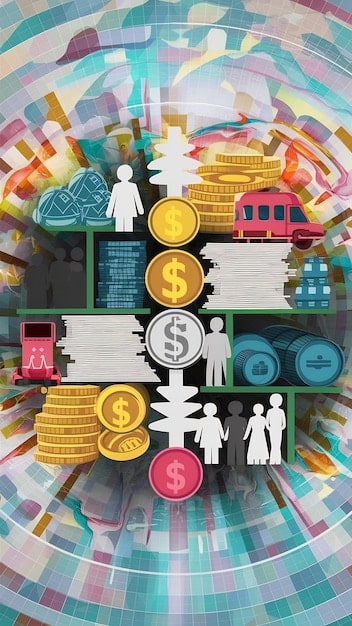Gen Z’s Financial Habits in the US: Are They Really Saving Less Than Previous Generations?

Gen Z’s financial habits in the US present a nuanced picture; while facing unprecedented economic challenges, their saving behaviors are distinct from, rather than inherently less than, prior generations, reflecting adaptability to a unique financial landscape.
In an era defined by rapid technological shifts and evolving economic landscapes, understanding Gen Z’s financial habits in the US: are they really saving less than previous generations? This question delves beneath simplistic narratives, exploring the intricate factors that shape how the youngest adult demographic manages their money, from student debt to digital payment preferences, and whether their approach truly deviates from those who came before them.
Unpacking the Economic Context for Gen Z
The financial landscape inherited by Gen Z is markedly different from that of previous generations. Born between the late 1990s and early 2010s, this demographic came of age during periods of significant economic volatility, including the lingering effects of the 2008 financial crisis and the unprecedented disruptions caused by the COVID-19 pandemic. These formative experiences have undeniably shaped their perceptions of financial security and risk.
Entering a Challenging Job Market
Gen Z embarked on their careers in an environment characterized by fluctuating job availability and increasing competition. Unlike earlier generations who might have enjoyed more stable entry-level roles, many Gen Zers faced a gig economy that offered flexibility but often lacked traditional benefits like employer-sponsored retirement plans. This reality has compelled them to think differently about their income streams and long-term financial planning.
- Increased Student Loan Burden: Many Gen Z individuals graduated with substantial student loan debt, a financial obligation that was less prevalent or impactful for earlier generations.
- High Cost of Living: The escalating costs of housing, healthcare, and everyday necessities have placed additional pressure on their budgets, making saving a more formidable challenge.
- Gig Economy Participation: A significant portion of Gen Z has embraced freelance and contract work, which can lead to irregular income and necessitate a more proactive approach to saving for emergencies and retirement.
The economic realities faced by Gen Z demand a critical examination beyond simple comparisons. Their financial decisions are often a direct response to a world where traditional pathways to wealth accumulation are shifting, requiring adaptability and innovative approaches to personal finance.
Understanding Gen Z’s Financial Priorities
When examining Gen Z’s financial habits, it becomes clear that their priorities are often influenced by their unique socioeconomic circumstances and a strong emphasis on experiences and values. While saving is still important, its role might be perceived differently.
One of the defining characteristics of Gen Z is their commitment to personal values, which often extend to their financial decisions. They are more inclined to support businesses that align with their ethical and social beliefs, even if it means paying a premium. This can sometimes impact their ability to save, as spending may be channeled towards purpose-driven consumption rather than solely accumulating wealth. They also prioritize experiences over material possessions, which can influence their spending patterns.
Short-Term vs. Long-Term Saving Goals
Gen Z often faces a dilemma between addressing immediate financial needs and planning for the distant future. The burden of student loan payments, coupled with high rental costs in urban areas, can make long-term investments seem out of reach. Consequently, their saving strategies might lean towards short-term objectives. For instance, many prioritize building an emergency fund or saving for a down payment on a first home, albeit often later in life than previous generations.
Their use of digital tools significantly impacts these priorities. Mobile banking apps, budgeting tools, and investment platforms have made financial management more accessible, enabling them to track spending and set specific, achievable goals. This digital fluency allows for greater transparency and control over their finances, even if the absolute amounts saved might appear smaller in comparison to previous generations who benefited from different economic conditions. Instead, their adaptability in managing resources becomes a key differentiator.
The Digital Native Advantage: FinTech and Saving
Gen Z, being the first truly digital-native generation, has seamlessly integrated technology into almost every aspect of their lives, and financial management is no exception. This immersion provides them with a distinct advantage in accessing and utilizing FinTech (financial technology) solutions, which fundamentally shape their saving habits.
Unlike previous generations who relied heavily on physical banks and traditional financial advisors, Gen Z navigates a world brimming with mobile banking apps, budget-tracking software, and micro-investing platforms. These tools offer unprecedented accessibility and insight into their financial flows, empowering them to make more informed decisions instantly. The convenience of these apps means they can check balances, set savings goals, and transfer money with just a few taps, fostering a more proactive and engaged approach to personal finance.
Micro-Investing and Passive Saving
The rise of micro-investing apps has particularly resonated with Gen Z. Platforms that allow users to invest spare change or small, recurring amounts make investing less intimidating and more attainable. This “set it and forget it” approach to saving aligns well with their desire for convenience and automation. While individual contributions might be small, the cumulative effect can be significant over time, marking a departure from the larger, lump-sum investments often associated with older generations.
- Automated Savings: Many FinTech apps offer features that automatically transfer small amounts from checking to savings accounts on a regular basis.
- Round-Up Investments: Programs that round up purchases to the nearest dollar and invest the difference make saving feel effortless.
- Budgeting Tools: Integrated budgeting features help Gen Zers visualize their spending and identify areas where they can cut back to increase savings.
This reliance on technology means that while their overall savings might not always surpass those of previous generations who saved under different economic circumstances, their methods are certainly more innovative and often more consistent, leveraging automation to build wealth incrementally.
Comparing Saving Behaviors Across Generations
Drawing direct comparisons between Gen Z’s saving behaviors and those of previous generations requires careful consideration of differing economic realities. Superficial numbers can be misleading without understanding the context in which each generation accumulated wealth.
For example, Baby Boomers and Gen X often entered the workforce during periods of robust economic growth, with lower education costs and more stable job markets. This allowed many to purchase homes earlier, benefit from defined-benefit pension plans, and accumulate assets at a different pace. Their saving patterns were largely shaped by traditional financial institutions and investment vehicles designed for long-term, stable growth. The prevailing wisdom was to save consistently in a dedicated savings account or through employer-sponsored plans.
The Impact of Debt and Inflation
Gen Z, in contrast, faces an environment burdened by higher student loan debt, soaring housing costs, and persistent inflation that erodes purchasing power. These factors inherently limit disposable income, making it challenging to save substantial amounts. What might appear as “less saving” by Gen Z could, in fact, be a reflection of proportionally lower discretionary income available after covering essential expenses and servicing debt.
Furthermore, attitudes towards saving have evolved. While previous generations often prioritized large savings accounts for emergencies or down payments, Gen Z sometimes views investment as a more dynamic form of saving, even if it carries higher risk. They are also more likely to diversify their income streams, supplementing traditional employment with gig work or side hustles, with the aim of increasing their saving capacity. This adaptive approach indicates a practical response to their financial environment rather than a lack of financial prudence.
Challenges and Opportunities in Saving for Gen Z
Gen Z faces a unique set of challenges when it comes to saving, yet their inherent adaptability and digital fluency also present considerable opportunities. Navigating these dynamics is crucial to understanding their financial trajectory.
One of the primary challenges is the pervasive influence of social media and consumerism. While digital platforms offer financial tools, they also expose Gen Z to constant advertising and comparisons with peers, potentially encouraging spending over saving. The pressure to participate in experiences or acquire trending products can create a financial strain, making it harder to adhere to a stringent savings plan. This constant digital bombardment is a new factor that previous generations did not contend with to the same degree.
Building Financial Literacy and Resilience
Despite obstacles, Gen Z shows a strong inclination towards improving their financial literacy. Many actively seek out information on budgeting, investing, and debt management through online resources, financial influencers, and educational content. This self-driven approach to learning equips them with the knowledge to make informed decisions and adapt to changing economic conditions.
- Focus on Diversified Income: Many Gen Zers explore multiple income streams, including side hustles and entrepreneurial ventures, to bolster their financial stability.
- Early Investment Awareness: Despite limited capital, a significant portion of Gen Z is engaging in micro-investing, building portfolios from an earlier age than previous generations.
- Prioritizing Emergency Funds: The economic uncertainty experienced during their formative years has instilled a strong emphasis on building robust emergency savings.
The opportunities for Gen Z lie in leveraging their digital literacy to automate savings, explore diverse investment avenues, and access personalized financial advice, often at a lower cost than traditional services. Their embrace of flexible work arrangements also allows for better income optimization. While challenges persist, Gen Z’s proactive stance on financial education and technology use positions them to build resilience and potentially achieve long-term financial security through alternative pathways.

The Future of Gen Z’s Financial Landscape
Projecting the future of Gen Z’s financial landscape involves synthesizing current trends, acknowledging potential shifts, and understanding how their values will continue to shape economic decisions. Their defining characteristics—digital native, socially conscious, and adaptable—will undoubtedly play a pivotal role.
As Gen Z matures, their impact on the economy will become more pronounced. Their preference for sustainable and ethical consumption is likely to drive market changes, influencing how businesses operate and how capital is allocated. This can indirectly affect their saving patterns, as they might prioritize investments in companies that align with their values, blurring the lines between financial gain and social impact. Their collective power as consumers and investors will force a re-evaluation of traditional financial models.
Evolving Attitudes Towards Homeownership and Retirement
Traditional markers of financial success, such as homeownership and retirement, may be redefined by Gen Z. While the desire to own a home remains, the exorbitant costs and increased mobility might lead to alternative living arrangements or delayed purchases. Similarly, the concept of a fixed retirement age is becoming less relevant, with many Gen Zers envisioning a more flexible career path that could extend well into later life, blending work with leisure.
This adaptability extends to their investment strategies. They are likely to embrace a broader range of assets, including cryptocurrencies and alternative investments, as they seek to navigate volatile markets. Their comfort with risk, coupled with access to real-time data, could lead to innovative approaches to wealth creation that deviate significantly from established norms. The future of Gen Z’s finances will be less about rigid adherence to past models and more about dynamic, personalized strategies that reflect their unique circumstances and aspirations.

Gen Z’s Resilience and Financial Adaptability
Ultimately, the question of whether Gen Z is saving “less” than previous generations is too simplistic to capture the nuances of their financial behavior. A comprehensive understanding requires a lens that considers the challenging economic environment they inhabit, their unique priorities, and their innovative use of financial technology. Their approach to money is less about adhering to past norms and more about adapting to present realities.
Gen Z has demonstrated remarkable resilience in the face of economic headwinds. They have witnessed recessions, pandemics, and rapid technological disruption during their formative years, experiences that have imbued them with a pragmatic and often cautious outlook on financial risk. This does not always translate into traditional savings accounts brimming with cash; instead, it can manifest as strategic debt management, diversified income streams, and early engagement with investment platforms, even if the sums are modest. Their financial journey is characterized by a conscious effort to build stability within a dynamic and often uncertain economic landscape.
The narrative should shift from a direct comparison of “more” or “less” to an exploration of “how” and “why” their financial habits differ. Gen Z is not necessarily saving less but saving differently, reflecting a generation that is financially agile, digitally savvy, and socially conscious. Their long-term financial outcomes will depend not only on economic conditions but also on their continued ability to leverage technology and adapt their strategies to a constantly evolving world.
| Key Point | Brief Description |
|---|---|
| 💸 Economic Headwinds | Gen Z faces high student debt, inflation, and a challenging job market, impacting disposable income. |
| 📱 FinTech Adoption | Leveraging apps for micro-investing, automated savings, and budgeting, shifting traditional saving methods. |
| 🎯 Shifting Priorities | Values-driven spending and experience over material goods influence their financial choices. |
| 💡 Financial Literacy | Proactive in seeking financial education online, embracing diverse income and investment strategies. |
Frequently Asked Questions about Gen Z’s Finances
Direct comparisons are complex as Gen Z faces unique economic challenges such as higher student debt and inflated living costs. While absolute savings might appear lower, their saving methods are different, often leveraging micro-investing and automated tools, making it a matter of different approaches rather than strictly less saving.
FinTech significantly impacts Gen Z’s saving habits by providing accessible tools like mobile banking, budgeting apps, and micro-investing platforms. These technologies enable automated savings, round-up investments, and better tracking of expenses, making financial management more integrated into their daily digital lives.
Gen Z faces significant financial hurdles, including a substantial burden of student loan debt, the rising cost of living (especially housing), and a competitive job market often dominated by the gig economy. These factors limit their disposable income and make traditional saving more difficult compared to older generations.
Yes, Gen Z often prioritizes experiences, values-driven spending, and financial literacy. They are more conscious of social and environmental impacts in their purchasing decisions, which can sometimes influence their budget. While they save for emergencies, their long-term goals for homeownership and retirement may also differ from traditional perceptions.
Gen Z has opportunities through their digital literacy, allowing them to leverage FinTech for smart budgeting and investing. Their adaptability to the gig economy provides diverse income streams, and their emphasis on financial education equips them to make informed decisions and build resilience in an evolving economic landscape.
Conclusion
The discussion surrounding Gen Z’s financial habits in the US reveals a reality that transcends simple quantitative comparisons. While they navigate a distinct economic landscape defined by student debt, elevated living costs, and an evolving job market, their approach to saving is characterized by ingenuity and adaptability. This generation is leveraging technology, diversifying income streams, and prioritizing financial literacy in ways that set them apart. Rather than saving “less,” Gen Z is often saving “differently,” crafting resilient financial strategies tailored to their unique circumstances and values, ultimately shaping a new paradigm for personal finance.





